
Getting To The ‘Cuore’ Of The Matter: Berkeley Lab Scientists Collaborate on Neutrino Science—Italian Style
Lab, Community Safety is a Two-Way Street
Getting To The ‘Cuore’ Of The Matter: Berkeley Lab Scientists Collaborate on Neutrino Science—Italian Style
It is often the case, if not the rule, in science that answering one question leads to further questions. When oscillation experiments at KamLAND and the Sudbury Neutrino Observatory unequivocally demonstrated that contrary to earlier beliefs neutrinos have mass, it answered the “missing” solar neutrinos question, but raised several new ones. Upon one of these questions may hang the fate of the Standard Model of particle physics: Are neutrinos their own antiparticle?
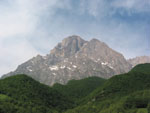 Gran Sasso, a mountain range in central Italy, is to be the home of the Cryogenic Underground Observatory for Rare Events (CUORE), and will shield the facility with nearly a mile of solid rock that has little natural radioactivity.
Gran Sasso, a mountain range in central Italy, is to be the home of the Cryogenic Underground Observatory for Rare Events (CUORE), and will shield the facility with nearly a mile of solid rock that has little natural radioactivity.
To answer this critical question, Berkeley Lab researchers have joined an international multi-institutional collaboration called “CUORE,” which stands for Cryogenic Underground Observatory for Rare Events. Located in the underground halls of the Laboratori Nazionali del Gran Sasso, which was built inside a highway tunnel through the Gran Sasso mountain range in central Italy, CUORE is designed to measure one of the rarest of all nuclear processes—neutrinoless double beta decay.
Detecting this process would indicate that the neutrino is a Majorana fermion, a fundamental particle of matter that serves as its own anti-particle (named for Ettore Majorana, the theorist who first proposed its existence). It should also provide the most sensitive estimate of the elusive neutrino’s very small mass, now estimated to be only 1/500,000th that of an electron.
“With CUORE we aim to carry out the first significant neutrinoless double beta decay experiments with enough sensitivity to have a good chance of establishing whether or not neutrinos are Majorana fermions,” said Stuart Freedman, a nuclear physicist with Berkeley Lab’s Nuclear Sciences Division. Freedman serves as the Contractor Project Manager for the U.S. Department of Energy (DOE) contribution to CUORE, and acts as the spokesperson for CUORE’s U.S. team of researchers. Richard Kadel, of Berkeley Lab’s Physics Division, is the Deputy Contractor Project Manager. Denis Peterson, of the Engineering Division, heads Project Planning and Controls.
“The question of whether neutrinos are Majorana particles was identified as one of the highest priorities in the field of particle physics in a report from the American Physical Society (The Neutrino Matrix, November 2004),” Freedman said. “Our experiments at CUORE should not only answer this question, but should also help us pin down the new neutrino properties that are implied by the discovery of neutrino mass.”
In a standard double beta decay, two neutrons are converted to two protons, releasing a pair of electrons and a pair of neutrinos. In a neutrinoless double beta decay, an emitted antineutrino in one of the beta decays can be absorbed as a neutrino in the other. The net result is the release of no neutrinos but two electrons that carry as much energy as the four particles emitted in a standard double beta decay. A neutrinoless double beta decay event is specifically forbidden by the Standard Model, but if it does take place, it is an event so rare that detecting one is like finding an exceptionally small needle in an exceptionally large haystack.
 Left: Standard double beta decay. As the nucleus (N) decays into a new nucleus (N’), two neutrons convert to protons, releasing two electrons (e-) and two antineutrinos (n).
Left: Standard double beta decay. As the nucleus (N) decays into a new nucleus (N’), two neutrons convert to protons, releasing two electrons (e-) and two antineutrinos (n).
Right: Neutrinoless double beta decay. If neutrinos and antineutrinos are Majorana, an antineutrino can be emitted from the first neutron (A), then absorbed as a neutrino by the second (B). Only the two electrons will be released, carrying all the decay energy.
To carry out this most difficult hunt, CUORE will deploy an array of 988 bolometers made from crystals of tellurium oxide and arranged in a cylindrical configuration of 19 vertical towers. A bolometer is an extremely sensitive device for measuring temperature fluctuations that result from the release of energy in the crystal. CUORE’s bolometers will be protected from background radiation by nearly a mile of mountainous rock that has a low rate of natural radioactivity, plus additional shielding of lead, polyethylene and a Faraday cage. The bolometers will operate at the cryogenic temperatures of 8 to 10 milli-degrees Kelvin, which reduces background noise even further.
“The cryogenic CUORE bolometers are source-detectors, meaning that the tellurium oxide detector material also serves as the source of the neutrinoless double beta decay,” said Freedman. “CUORE will feature the largest cryogenic array ever realized, a one-ton detector system capable of investigating the Majorana mass to the 30 meV scale.”
A key part of the CUORE bolometers will be a “thermistor,” a solid-state thermometer whose electrical resistance changes drastically in response to the most minuscule of temperature changes. Berkeley Lab’s Eugene Haller, a physicist with the Materials Sciences Division, has developed thermistors based on germanium that’s been doped via neutron transmutation. Approximately 2,500 of these thermistors will be attached to CUORE’s tellurium oxide crystal to measure temperature fluctuations produced by double beta decay events.
Said Haller, “The father of the CUORE project, Professor Ettore Fiorini from the University of Milano, came many years ago to Berkeley to discuss with us the formation of Neutron Transmutation Doped (NTD) germanium thermistors. Over the years we’ve made hundreds of such sensors for him. What makes these germanium thermistors unique is their uniformity thanks to the NTD process which is performed in a nuclear reactor. We can dope precisely as close to the point where the semiconductor turns into a metal as we wish. Our thermistors can also be operated at the ultra-low temperatures needed to provide sufficient sensitivity for the CUORE experiment.”
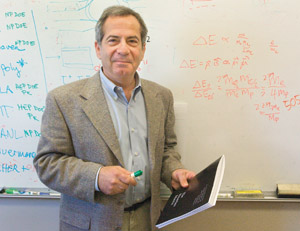 Stuart Freedman, a physicist in Berkeley Lab’s Nuclear Science Division, is Contractor Project Manager and spokes-person for the CUORE U.S.A. team
Stuart Freedman, a physicist in Berkeley Lab’s Nuclear Science Division, is Contractor Project Manager and spokes-person for the CUORE U.S.A. team
In addition to being responsible for the fabrication of the NTD germanium thermistors, Berkeley Lab researchers are also responsible for developing an independent analysis framework for CUORE, and for characterizing sources of background radiation in various components of CUORE that will help in the development of a calibration system. Berkeley Lab is also assisting with the production of the tellurium oxide crystals.
CUORE is not expected to begin collecting data until 2010, but a preview of coming attractions is being provided by an experiment that has been underway at the Laboratori Nazionali del Gran Sasso since 2003. This experiment is called CUORICINO, which is Italian for “Small CUORE.” Consisting of a single tower of CUORE-style cryogenic bolometers, CUORICINO is demonstrating that the technology behind CUORE works. Already, the CUORCINO experiment is helping to set new limits on neutrino mass.
“Only double beta decay experiments can achieve the goal of determining whether neutrinos are Marjorana particles,” said Freedman. “The technology is now proven and with adequate funding ($10 million is in the President’s FY2008 budget) there should be no show-stoppers. CUORE is by far the most cost-effective next-generation double beta decay experiment that’s been proposed.”
Among the other Berkeley Lab researchers participating in the CUORE collaboration are Jeff Beeman, Patrick Decowski, Alan Smith, Elena Guardincerri, Yury Kolomensky and Nu Xu, plus graduate students Adam Bryant and Laura Kogler.
In addition to Berkeley Lab, the United States CUORE team includes scientists from UC Berkeley and Lawrence Livermore National Laboratory, UCLA, Caltech, the University of Wisconsin and the University of South Carolina.
Lab, Community Safety is a Two-Way Street
Dan Lunsford calls it a “cloak of protection” – an interlaced network of services and resources that offers layers of safety and security to employees at Berkeley Lab. This invisible shield goes well beyond the fire department and the security guard team. Knowing this should offer an extra measure of comfort for those who live and work here every day.
Lunsford is Security and Emergency Operations Group Leader for the Lab, and he knows that when you exist in a populated region among residential neighborhoods and thick hillside vegetation, security and safety is a two-way street. Resources pass back and forth across borders, and deals are brokered to protect citizens on both sides of the fence.
“We enjoy a host of relationships with the community for emergency aid,” Lunsford said. “We benefit greatly, and the community benefits from us being here. And these partnerships exist at the state, county and local levels.”
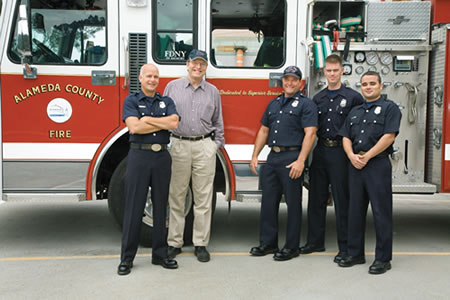 (From left) Engineer Jay McGill, Gary Piermattei (Berkeley Lab), Captain Chip Anderson, Firefighter Garrett Brown and Firefighter Derek Huber
(From left) Engineer Jay McGill, Gary Piermattei (Berkeley Lab), Captain Chip Anderson, Firefighter Garrett Brown and Firefighter Derek Huber
The Lab’s fire department services are a good example. Alameda County provides the personnel and management to maintain 24/7 fire protection of Lab facilities, including state-of-the-art hazardous material response equipment only 20 minutes away. At the same time, the department provides services to off-site locations adjacent to the Lab – some 70 percent of its total response activity is in the City of Berkeley.
“It’s being a good neighbor, and it keeps our firefighters on the cutting edge of training,” Lunsford said. “There is no substitute for actual calls to service.”
At the same time, the city is on call to respond to any multi-alarm emergency that might come up at the Lab, a “mutual aid” commitment that also exists with Oakland and the East Bay regional fire district. As a member of the Hills Emergency Forum, Berkeley Lab works with six other partner agencies to ensure that brush and tree fires are monitored, controlled and prevented.
A similar synergy exists with the University of California police department on the Berkeley campus, and the city of Berkeley’s police force is ready with backup as needed, just minutes away.
The Lab is a member of the Alameda County Operational Area Council, and as such it helps in prioritizing programs and projects for Department of Homeland Security funding, in addition to shaping emergency management policies and procedures for responding to, and training for, crises. The county’s medical and trauma centers, hospitals and clinics are all accessible for Lab employee needs during regional events through mutual aid agreements. Lab subject matter experts make themselves available to outside communities for things such as radiation assessment and other technical or scientific needs.
Lunsford’s security and emergency management staff of Genevieve Pastor-Cohen, Rocky Saunders, and Gary Piermattei coordinate regular training and simulation sessions with the Lab’s Emergency Response Organization, and the Lab participates in an annual joint exercise with the state, county, city and campus preparing for events like earthquakes and terrorist attacks.
Add to all of this the Lab’s own Crisis Action Team, headed by Labor and Employee Relations Manager Bill Elkins, which assists managers in addressing potential workplace violence issues; Lab security’s ongoing relationships with Department of Energy counterintelligence, Inspector General, FBI, local law enforcement and fire, and formal affiliations with the Governor’s State Office of Emergency Services, and the Lab would appear to be pretty much covered in security and emergency protection. Like a cloak, you might say.
Alvarez Computing Fellow Revels In Lab’s Collaborative Spirit
It was his love for math and engineering—and a determination to pursue a better education—that prompted George Pau to leave Malaysia four years ago for the United States. That same drive for promising opportunities brought him to Berkeley Lab a month ago as the new Luis W. Alvarez Fellow in Computational Science.
Pau, 29, came here after earning his Ph.D. in mechanical engineering at the Massachusetts Institute of Technology, where he was drawn into the world of developing numerical methods for solving chemistry problems. As a fellow, Pau plans to broaden his research scope to include the understanding of multiscale phenomena in physical systems and the exploration of how numerical methods could enhance nanostructure designs.
“I am glad to be at Berkeley Lab, because scientists here collaborate extensively on developing codes. It allows me to see how it can be done,” said Pau.
When he applied for the fellowship, he wanted to work with John Bell, Director of the Center for Computational Sciences and Engineering in the Computational Research Division. Pau got his wish and now works out of a wing in Building 50A, among researchers who develop algorithms and mathematical models for combustion, supernovae and subsurface flow, for example
”George is a pleasure to work with. Although he has only been at the Lab for a month, he is already making significant contributions to our research programs,” said Bell.
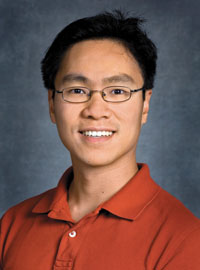 George Pau is this year’s Luis W. Alvarez Fellow in Computational Science
George Pau is this year’s Luis W. Alvarez Fellow in Computational Science
Polite and engaging, Pau grew up in Malaysia, in the city of Miri on the northwestern shore of the Borneo island. Being a doctor or an engineer confers a prestige not available to other professions in Malaysia. So when it was time to decide on a major in college, Pau picked mechanical engineering. It wasn’t a tough choice.
“I can’t become a doctor because I don’t like the sight of blood, so the only choice was engineering,” Pau said with a smile.
He excelled in school and won a scholarship and a promise from the government to send him to the United Kingdom for undergraduate study. But the government found itself lacking money to fulfill that promise when the 1997 Asian economic crisis hit. So it placed Pau in a newly built university. Pau was part of the first graduating class at the Petronas University of Technology in 2001, when he earned a degree in mechanical engineering.
What to do next? Malaysia’s higher-education system couldn’t offer him rigorous course work beyond college, he said. “I’ve always wanted to get a Ph.D., so I decided to go to Singapore for a master’s degree,” Pau said.
The neighboring country gave him a great opportunity—Pau enrolled in the Singapore-MIT Alliance program at the National University of Singapore. The alliance began in 1998 to provide educational and research collaboration in engineering and life science.
It was at the National University where Pau first learned about numerical methods, which enable scientists to understand the properties and behavior of a phenomenon through computer simulations. This research area has a broad application in many industries, including the discovery of stable chemical compounds and improved turbine designs in power plants.
MIT accepted Pau into its Ph.D. program after he worked for Motorola in Singapore for a year. At MIT, Pau became interested not only in developing numerical methods but also in analyzing existing methods and improving their efficiency. Quantifying and reducing calculation errors are some of the challenging problems Pau will tackle during his fellowship.
Moving across the country for the fellowship is just one of the big changes in his life. Two months ago, Pau married Ming Lee Tang, a fellow Malaysian who is now a graduate student in chemistry at Stanford University. The couple met when Tang attended Brandeis University, near MIT.
Outside of work, Pau enjoys hiking, sea kayaking and tennis. He also loves to cook and counts beef rendang, along with braised duck in a five-spice powder and galanga (a root that resembles ginger) concoction, as some of his signature dishes.
Congresswoman Lee Visits Lab, Discusses Education, Energy and Public Health
Congresswoman Barbara Lee and her District Director, Leslie Littleton, visited Berkeley Lab and UC Berkeley on August 7 to learn more about the Lab’s and campus’ research programs in energy and public health, and to discuss science and engineering education outreach efforts. Rep. Lee’s visit to the Lab is the first since the Democratic Party took control of the Congress and she was appointed to the powerful House of Representatives’ Appropriations Committee.
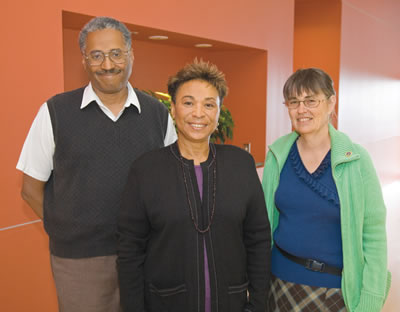 Teachers Charles Brown of Castlemont Business and Information Technology School (left) and Katie Noonan of Oakland High spoke with Congresswoman Barbara Lee (center) about the benefits of their experience in the Lab’s teacher academy.
Teachers Charles Brown of Castlemont Business and Information Technology School (left) and Katie Noonan of Oakland High spoke with Congresswoman Barbara Lee (center) about the benefits of their experience in the Lab’s teacher academy.
After a tour of the Molecular Foundry given by Foundry Director Carolyn Bertozzi, Director Steve Chu and UCB Vice Chancellor for Research, Beth Burnside, gave an overview of the federally funded research at the Lab and on campus. Although Lee was aware that the Lab was primarily funded by the U.S. Department of Energy, she was pleased to learn of the significant levels of funding from the National Institutes of Health. As a member of the Labor HHS Education Appropriations Subcommittee and as a former public health community organizer, the Congresswoman expressed her support for health research. Joe Gray, Associate Laboratory Director for the Life Sciences, gave a brief presentation on a collaborative cancer research initiative with UCSF and UC Berkeley.
Laurel Egenberger, Acting Director of the Center for Science and Engineering Education, briefed the Congresswoman about the Lab’s High School Student Research Participation Program, and the Academies Creating Teacher Scientists program. Joining Egenberger were two high school science teachers. Katie Noonan of Oakland High and Charles Brown of Castlemont Business and Information Technology School spoke with Lee about their experience in the teacher academy and how it was benefiting their students. Brown noted that he is seeing an increase in the number of students interested in pursuing degrees in engineering as a direct result of implementing programs and activities he learned at the academy.
An impressive panel of climate change and energy research scientists provided a broad overview of collaborative research between campus and the Lab. On the demand side, Rick Diamond, Deputy Group Lead of the Lab’s Energy Performance of Buildings Group, talked about his team’s work on the “Greening of the U.S. Capitol,” which included an audit of Lee’s Capitol Office. He encouraged her to have the Lab audit her District Office as well.
On the energy supply side, Energy Biosciences Institute Director (designee) Chris Somerville discussed the promise of biofuels, and Associate Laboratory Director for the Physical Sciences Paul Alivisatos discussed his lab’s work on the next generation of nano-inspired photovoltaic cells.
Berkeley Lab View
Published once a month by the Communications Department for the employees and retirees of Berkeley Lab.
Reid Edwards, Public Affairs Department head
Ron Kolb, Communications Department head
EDITOR
Pamela Patterson, 486-4045, pjpatterson@lbl.gov
Associate editor
Lyn Hunter, 486-4698, lhunter@lbl.gov
STAFF WRITERS
Dan Krotz, 486-4019
Paul Preuss, 486-6249
Lynn Yarris, 486-5375
CONTRIBUTING WRITERS
Ucilia Wang, 495-2402
Allan Chen, 486-4210
David Gilbert, (925) 296-5643
DESIGN
Caitlin Youngquist, 486-4020
Creative Services Office
Berkeley Lab
Communications Department
MS 65, One Cyclotron Road, Berkeley CA 94720
(510) 486-5771
Fax: (510) 486-6641
Berkeley Lab is managed by the University of California for the U.S. Department of Energy.
Online Version
The full text and photographs of each edition of The View, as well as the Currents archive going back to 1994, are published online on the Berkeley Lab website under “Publications” in the A-Z Index. The site allows users to do searches of past articles.
Flea Market is now online at www.lbl.gov/fleamarket
Lab Pitches in for Homeland Security
In a spotless lab on the fifth floor of the Molecular Foundry, the Department of Homeland Security’s (DHS) Science and Technology Director of Research listened to a graduate student explain her work developing a sensor that can detect harmful chemicals and biological agents.
The DHS visitor earlier this month was Starnes Walker, and he spoke with Gloria Olivier from Johns Hopkins University, who is spending 10 weeks at the Lab as a DHS summer fellow. Their brief chat was just one stop on a whirlwind tour in which Walker met with Director Steve Chu and more than a dozen Lab scientists, and learned about a wide range of research projects that are focused on safeguarding the nation.
Walker’s visit stems from a DHS goal to increase the fundamental research portion of its portfolio. Because no one can be sure what the next homeland security threat will be, it’s best to be prepared for just about anything, which means ramping up basic research. And this means paying a visit to Berkeley Lab.
“Berkeley Lab is the kind of place that has the breadth and depth of fundamental research that DHS needs to leverage,” said Walker.
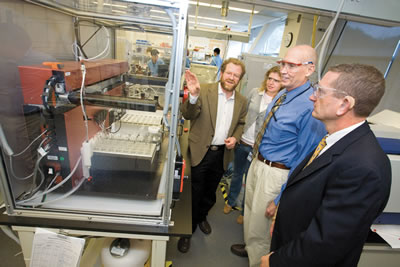 From left to right: Lab scientist Ron Zuckerman, Department of Homeland Security (DHS) summer fellow Gloria Olivier, and DHS’s Starnes Walker and Jamie Johnson
From left to right: Lab scientist Ron Zuckerman, Department of Homeland Security (DHS) summer fellow Gloria Olivier, and DHS’s Starnes Walker and Jamie Johnson
Specifically, Walker met with Lab scientists who are exploring ways to safeguard the electricity grid, cyberspace, and buildings. Others are developing ways to detect hidden explosives and biological agents, or sift through mountains of data for the telltale signs of wrongdoing. The Lab doesn’t have a mandate to conduct homeland security research, but many of the projects conducted at the Lab can be easily parlayed to protecting the nation. For example, a tiny microarray developed by Lab scientists to catalog DNA in a sample can also detect the genetic signature of biological weapons.
“It is very satisfying when we conduct fundamental research that is also critical to protecting the nation,” says Rob Johnson, who heads the Lab’s Homeland Security Office, a program in the Directorate that manages R&D in homeland security, intelligence, counterterrorism, and nuclear nonproliferation.
Educating the next generation of scientists is also a key component of DHS’s research goals, which is why Walker took the time to meet with two of the five graduate students who are DHS Fellows working at Berkeley Lab as summer interns.
“This is a place where DHS scholars and fellows can work with some of the best minds in science,” said Walker. “Another great advantage is that Berkeley Lab brings together different disciplines under one roof, such as at the Molecular Foundry.”
In addition to meeting Olivier, a graduate student working with Ron Zuckermann of the Molecular Foundry, Walker met with Thomas Stratton of Purdue University and his mentor Frank Svec. Stratton is working on a project to develop microfluidic chips that separate proteins for potential use in the detection and characterization of biological agents.
Other DHS summer interns include Willie Kaye of the University of Michigan. He’s working with Paul Luke of the Engineering Division on room-temperature semiconductor gamma-ray detectors. He’s also assisting in studies to determine the origin of defects in aluminum antimonide crystals, which is a promising radiation detector material.
Ruchi Varma from Brown University is working with Phil Price and Doug Black of the Environmental Energy Technologies Division. Her work focuses on optimizing computer models that track contaminant dispersion within buildings, which is dependent on a number of factors, such as the operation of HVAC systems and the environmental differences between the inside and outside of buildings.
And Dong Ryeol Lee from Georgia Institute of Technology is working with Deb Agarwal of the Computational Research Division. He’s adding workflow capabilities to software that analysts use to search databases for relationships among data. Dong is working to enhance the software’s security to allow workflow to be shared by a group of analysts.
FIRST PERSON
The High School Student Research Participation Program (HSSRPP), conducted each summer by the Lab’s Center for Science and Engineering Education (CSEE), culminated on Aug. 10 in a series of 10-minute presentations given by the student participants in the Building 50 Auditorium. The room was packed full of family, friends, and Lab employees, all there to see the results of six and a half weeks of work on the part of a small group of high school students.
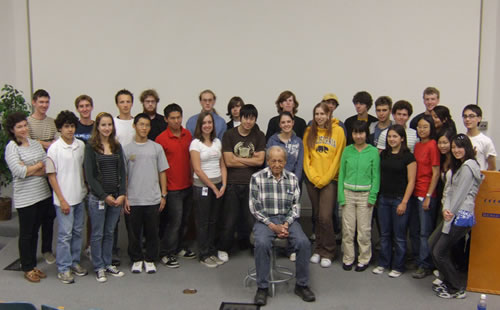 The 2007 class of the High School Student Research Participation Program, with mentor Al Ghiorso in the forefront
The 2007 class of the High School Student Research Participation Program, with mentor Al Ghiorso in the forefront
With science education featured prominently in the news, the HSSRPP program is no longer just a Lab event. Politicians took notice, too, with congratulatory notes being sent in from House Speaker Nancy Pelosi, Senator Dianne Feinstein, Senator Barbara Boxer, and Representative Ellen Tauscher. Senator Don Perata even sent a representative to attend the presentations. Laurel Egenberger, acting head of CSEE, introduced the event, prepping the audience to be “blown away.” Then the presentations began, spanning from 9:30 in the morning until 4:00 in the afternoon.
Gathering in the auditorium on the day of the presentations brought back memories of a morning just six and a half weeks earlier, the first day of the HSSRPP. I was one of 30 soon-to-be high school seniors and college freshmen to attend the program’s orientation in June, and at the time I could hardly believe that I was there—on the hill, at the Lab, in a position I had only thought attainable in my wildest dreams.
This summer, CSEE’s outreach program brought in high school students not only from the Bay Area, but also from as far away as Hawaii and Pennsylvania, selected from a pool of applicants numbering in the hundreds. Once here, students undergo a rigorous orientation and are then paired with mentors who serve as a guide to each student‘s experience in a lab. After safety training is undergone, the students move on to get a taste of what working at Berkeley Lab is like. The program is designed to bring young people into the world of science and, as the CSEE staff readily admit, hopefully to keep them there.
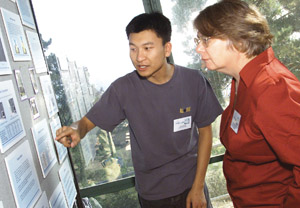 CSEE Acting Head Laurel Egenberger (right) listens intently at a student poster session
CSEE Acting Head Laurel Egenberger (right) listens intently at a student poster session
Entering the program is no easy task. Grades, especially those in classes related to the sciences, are a large factor in the selection process. Also weighed heavily are teacher recommendations. And, of course, the student must be eager to work at the Lab, and this must shine through in their application. Surveying my application at the beginning of the process, I had my doubts, since science was not my primary strength in high school. But amidst the intimidating aspects of the application was one glimmer of hope: a section in which the student is encouraged to share past experiences and interests.
Stressing my interest in internet technology and communication, and receiving a recommendation from my English teacher, I was accepted and placed in the Communications Department, where I spent several weeks working on new web page designs for various projects within the department. Working with science writers to improve the way Lab research news gets out to the public via the Internet has been a rewarding experience. I enjoyed the work, and learned a great deal in the process of doing it, not only about how to accomplish the technical tasks required of me, but also about the workplace itself, including the workings behind the Communications Department, and its role in sharing the science performed at the Lab with the outside world.
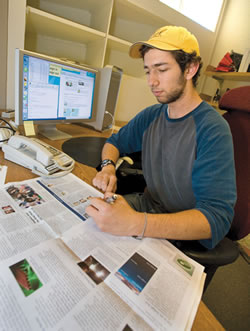 Summer High School Student Michael Pruess at his post in the Communications Department
Summer High School Student Michael Pruess at his post in the Communications Department
In spite of the fact that, as CSEE’s Dale Koistinen remarked to us many times, “This is a workplace rather than a classroom,” the truth is that each student is constantly learning: each student learns at least a little about the work of their mentor; each student gains skills relevant to their own work. Most importantly, each student learns what it is like to work, be it in a laboratory or in a cubicle, for eight hours every day. Robert Moses, a student in the program who has been working with bone tissue replacement technology, echoed the sentiments of many of the students in the program: “This has been a great opportunity to learn about working in a lab and really do science.”
The presentations given by the students on Aug. 10 revealed the diversity in their assignments. Working in a variety of places under different mentors, the students’ work ranged from inventorying fire extinguishers, to designing the base for a vacuum chamber, to scanning documents, to determining the structures of proteins. Some students traveled around the Lab investigating various projects in different buildings, while others worked in the same place every day.
With final presentations being held in the Building 50 Auditorium, the same place where earlier in the summer we were first greeted by program supervisors, I found myself brought full circle to the beginning of the program, thinking back on the differences between our experience then and now. I realize how valuable HSSRPP has been to us, and how that contrast helps showcase what each of us found important in our time here.
Michael Pruess contributed this article during his tenure as a High School Student Research Program participant in the Communications Department.
Berkeley Lab Science Roundup
Fabricating Striped Nanorods
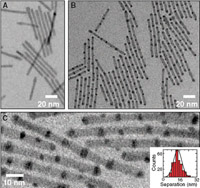 In these Transmission Electron Microscope images of superlatticed or striped nanorods formed through partial cation exchange, (A) shows the original cadmium-sulfide nanorods; (B and C) show cadmium-sulfide nanorods striped with silver-sulfide. The inset is a histogram showing the pattern spacing of the silver-sulfide stripes.
In these Transmission Electron Microscope images of superlatticed or striped nanorods formed through partial cation exchange, (A) shows the original cadmium-sulfide nanorods; (B and C) show cadmium-sulfide nanorods striped with silver-sulfide. The inset is a histogram showing the pattern spacing of the silver-sulfide stripes.
Superlatticed or “striped” nanorods – crystalline materials only a few molecules in thickness and made up of two or more semiconductors – are highly valued for their potential to serve in a variety of nanodevices, including transistors, biochemical sensors and light-emitting diodes. Until now the potential of superlatticed nanorods has been limited by the relatively expensive and exacting process required to make them. That paradigm may be shifting.
A team of Berkeley Lab and UC Berkeley scientists has found a way to make striped nanorods in a colloid – a suspension of particles in solution. Previously, striped nanorods were made through processes in which the rods were attached to or embedded within a solid medium.
“We have demonstrated the application of strain engineering in a colloidal quantum-dot system by introducing a method that spontaneously creates a regularly spaced arrangement of quantum dots within a colloidal quantum rod,” said chemist Paul Alivisatos, Director of the Materials Sciences Division and Associate Laboratory Director for Physical Sciences at Berkeley Lab.
Ultraclean Combustion Technology
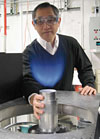 Robert Cheng views an LSI flame. He is touching the burner, demonstrating that it stays cool because the flame is completely lifted from its body.
Robert Cheng views an LSI flame. He is touching the burner, demonstrating that it stays cool because the flame is completely lifted from its body.
An experimental gas turbine simulator equipped with an ultralow-emissions combustion technology called LSI has been tested successfully using pure hydrogen as a fuel – a milestone that indicates a potential to help eliminate millions of tons of carbon dioxide and thousands of tons of NOx from power plants each year.
The LSI (low-swirl injector) technology, developed by Robert Cheng of the Environmental Energy Technologies Division, recently won a 2007 R&D 100 award from R&D magazine as one of the top 100 new technologies of the year.
The LSI holds great promise for its near-zero emissions of nitrogen oxides, gases that are emitted during the combustion of fuels such as natural gas during the production of electricity. Nitrogen oxides, or NOx, are greenhouse gases as well as components of smog.
Wiring Living Cells
 A scanning electron microscope reveals individual mouse embryonic stem cells penetrated by silicon nanowires.
A scanning electron microscope reveals individual mouse embryonic stem cells penetrated by silicon nanowires.
One day it may be possible for physicians to use electrical stimulation to guide the development of embryonic stem cells into neurons, heart cells, lung cells, breast cells, muscles, and other specific cell types. Researchers with Berkeley Lab and UC Berkeley, in collaboration with researchers at the Gladstone Institute of Cardiovascular Disease in San Francisco, have taken a critical first step toward that goal.
The researchers have developed a technique by which silicon nanowires can be embedded in a living cell, with no apparent harm to the cell. The technique can be used to connect individual cells to one another and to wire the cells to external sensors and other electronic devices. It may also have the potential to deliver genetic material to specific organelles within a cell.
“This is the first example of nanowires interfacing with biological cells without the use of external force,” says Lab chemist Peidong Yang, who led the research.
Chemical-Free Bioremediation
 Dechloromonas is a strain of proteobacteria that can effectively perform bioremediation on perchlorates, even in an anaerobic environment. (Image by John Bozzola and Steven Schmidt, Image Facility of Southern Illinois University, Carbondale)
Dechloromonas is a strain of proteobacteria that can effectively perform bioremediation on perchlorates, even in an anaerobic environment. (Image by John Bozzola and Steven Schmidt, Image Facility of Southern Illinois University, Carbondale)
Bioremediation is Mother Nature’s way of cleaning up after herself. This process, in which microbes restore a contaminated environment to its original condition, has also been used by humans for thousands of years. Even today, however, human-engineered bioremediation can be a slippery balancing act, where the addition of just the right amount of organic or inorganic chemicals stimulates a given microbe population to consume just the right amount of contaminant. Adding too much or too little can result in problems.
For at least one common contaminant of drinking water and groundwater, the curtain may be coming down at last on this delicate chemical balancing act. Berkeley researchers have developed a chemical-free bioremediation technique for removing perchlorate from water.
“We’ve demonstrated that microorganisms can utilize electrons donated from the cathode” — the negatively charged electrode — “of an electrochemical cell in lieu of chemical electron donors,” says microbiologist John Coates, the leader of this research. “When the electron acceptor is a contaminant, bioelectrical stimulation of microbial reduction of that contaminant can be used as a bioremediative strategy.” Coates holds joint appointments with Berkeley Lab’s Earth Sciences Division and UC Berkeley’s Department of Plant and Microbial Biology.
Return to Wild 2
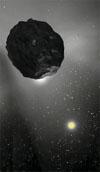 On its encounter with Comet Wild 2 in January, 2004, the Stardust spacecraft flew through a cloud of dust and gas. (Courtesy NASA/JPL-Caltech)
On its encounter with Comet Wild 2 in January, 2004, the Stardust spacecraft flew through a cloud of dust and gas. (Courtesy NASA/JPL-Caltech)
NASA’s Stardust mission was the first to bring back pristine samples of Comet Wild 2 and the first to return dust particles directly from interplanetary space. It would not have been surprising if these materials had given evidence of a shared origin — a very cold one at that.
In fact the early results from Stardust’s Preliminary Examination Teams (PETs), reported in Science magazine in December, 2006, were full of surprises. As Stardust principal investigator Don Brownlee said, shortly after scientists had taken their first peek at the samples, “We have found fire and ice. In the coldest part of the Solar System, we have found samples that have formed at extremely high temperatures.”
The apparent anomaly of the comet’s origins was vividly displayed in the analysis of Stardust’s carbon-based compounds as initially reported by the organics Preliminary Examination Team. Stardust’s unusual mix of organics has now been revisited in a detailed study to be published in the journal Meteoritics and Planetary Science.
The instruments of choice for analyzing Stardust’s organics were STXMs (“sticks-ums”), scanning transmission x-ray microscopes, which use very high-brightness radiation from synchrotrons. Of the three STXMs used in the study, one was at Brookhaven National Laboratory’s National Synchrotron Light Source and two were at Berkeley Lab’s Advanced Light Source, those on beamline 5.3.2 and beamline 11.0.2.
Fung Wins Distinguished Climate Modeling Award
Inez Fung, a climate expert and NERSC user, recently received the 2007 Community Climate System Model (CCSM) Distinguished Achievement Award for her role in shaping a modeling system that enables scientists to carry out comprehensive analyses of the earth’s climate.
Fung, a researcher at Berkeley Lab’s Earth Sciences Division and a UC Berkeley professor, was given the plaque by the CCSM organization during its annual workshop in June. CCSM is an organization supported by the National Science Foundation and the DOE and run by the National Center for Atmospheric Research in Colorado.
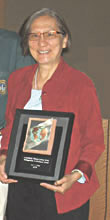 Inez Fung
Inez Fung
The award recognized Fung’s leadership in founding the Biogeochemistry Working Group in 1998 and steering its direction to coordinate research and develop biogeochemical components for the CCSM. Fung provided “the intellectual guidance and energy behind the transformation of the CCSM from a physical climate model into a comprehensive earth system model,” said Dr. Peter Gent, Chair of the CCSM Scientific Steering Committee. “These capabilities allow us to explore a whole new range of critical interactions and feedbacks between atmospheric composition, ocean and land bio-sphere and climate.”
The National Center for Atmospheric Research started the CCSM in 1983 as a global atmosphere model that focused primarily on the physics and mathematics of the earth in studying climate. Starting in the mid-1990s, however, scientists began to expand the model to include other elements that shape the global climate, such as oceans and sea ice. The CCSM then formed working groups within each discipline together with the Scientific Steering Committee to undertake long-term projects on further broadening the scope and applications of the model.
In her work leading the Biogeochemistry Working Group, Fung contributed to the launch of an interactive carbon cycle model within the CCSM and shepherded the new project (in collaboration with ORNL and LLNL) to prototype a new system to diagnose verisimilitude of the carbon simulations.
Fung said NERSC’s support has been essential for her work at the CCSM.
“Computing at NERSC has been indispensable for testing new ideas about the climate system, and for demonstrating their significance by large numbers of long integrations,” Fung said.
She currently is a principal investigator of a project being carried out at NERSC. The project, “Carbon-Climate Interactions,” aims to develop a more accurate modeling of carbon dioxide in the atmosphere and its impact on the climate. In previous research, Fung’s team specified fossil fuel emission scenarios in their model. The current work will take into account new scenarios related to the growing population demand for food and water.
The research also will continue to broaden the biogeochemical scope of the CCSM by adding components such as water isotopes and mineral aerosols. Fung is the co-PI on a newly funded DOE project to assimilate large volumes of satellite observations of CO2 into the carbon-climate model to yield the first global observation of the geographic variations of atmospheric CO2. For more information about Fung’s research, check out http://www. atmos.berkeley.edu/~inez.
Bennett to Lead Development of Energy-Efficient Ethernet


L-R: Mike Bennett, Bruce Nordman
Berkeley Lab network engineer Mike Bennett of the Information Technology infrastructure group has been chosen to lead the development of a standard for Energy-Efficient Ethernet. An outgrowth of the work of a study group that Bennett chaired, the new protocol will provide that the Ethernet rapidly change speeds during periods of low link-utilization in order to reduce energy use, using Adaptive Link Rate technology. The standard flows from the work of Bruce Nordman of Environmental Energy Technologies on the Energy Efficient Digital Networks project, which aims to reduce electricity use of electronics through a variety of methodologies. The project to write the new standard will be ready for approval next month. The new standard is expected to take two years to reach completion, the cycle of most Ethernet projects.
People, Awards, and Honors

Lab’s Information Officer Elected to Internet2 Panel
The first-ever elections have been held to select members of the Internet2 Advisory Councils, and Berkeley Lab Chief Information Office Rosio Alvarez was chosen to sit on the Research Advisory Council. Internet2 is the foremost U.S. advanced networking consortium. Led by the research and education community since 1996, Internet2 provides both leading-edge network capabilities and unique partnership opportunities that together facilitate the development, deployment and use of revolutionary Internet technologies.

Photosynthesis Award For Lab Bioscientist
Junko Yano, with Berkeley Lab’s Physical Biosciences Division, has received the Robin Hill Award, given by the International Society for Photosynthesis Research. The honor is given to scientists under 40 years of age for outstanding investigations into physical aspects of the photosynthesis process. Recent research by Yano includes deriving high-resolution structure of a catalyst that drives photosynthesis, which may help inform the development of solar-based energy technologies.


Earth Scientists Elected To Geological Society
Berkeley Lab earth scientists Hui Hai Liu (left) and Karsten Pruess have been elected fellows of the Geological Society of America. Liu was recognized for his “contributions to variable density flow in porous media, factal-based conceptualization of subsurface heterogeneity, flow and transport in unsaturated fractured rock, and scale-dependent matrix diffusion in fractured rock.” Pruess, who received the GSA’s Meinzer Award last year, was honored for his use of advanced numerical simulation and development of computer coding to study fluid flow in natural porous media.